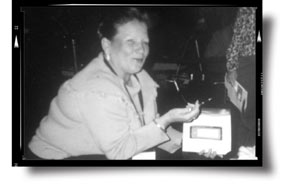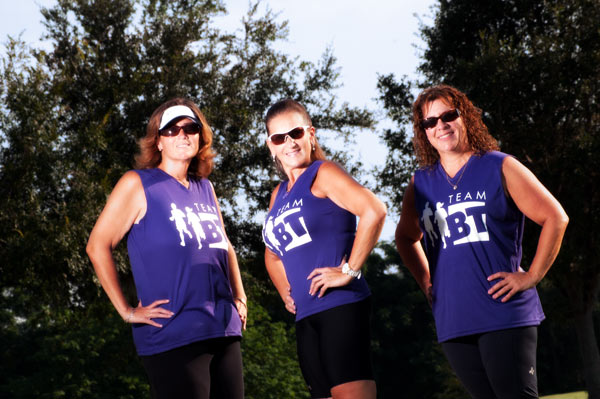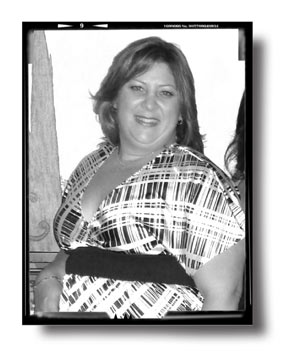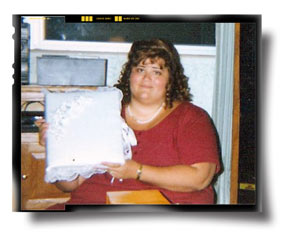
 At 273 pounds and 40 years old, Jacqui Ferko was at a personal and medical crossroad. Her husband Scott had recently been killed in a motorcycle accident, she was now a single mother of three children and her weight issues were causing serious health problems. Simply put, her life was in crisis.
At 273 pounds and 40 years old, Jacqui Ferko was at a personal and medical crossroad. Her husband Scott had recently been killed in a motorcycle accident, she was now a single mother of three children and her weight issues were causing serious health problems. Simply put, her life was in crisis.
And it would take a blunt, honest answer to a question to change Jacqui’s life for the better.
“Because of my weight, I had a lot of digestive problems, like acid reflux,” says Jacqui. “Finally, my doctor told me I had to have gallbladder surgery. And while I was in the recovery room, I was told that the condition of my gallbladder was one of the worst the doctor had ever seen.”
When Jacqui asked why, she got a matter-of-fact response: “Because you’re fat.”
It was Jacqui’s wake-up call.
“No one had ever just told me that I was fat,” she says. “It was harsh, but it made me really take a look at myself and think about how being overweight was affecting my health. I thought about my children and how they needed me. Then I made a promise right then and there to change my life.”
Having struggled with weight issues all her life, it wasn’t that Jacqui hadn’t attempted to lose the weight before. Indeed, she admits that she “tried every fad diet and even medically supervised ones.” But any weight loss was only short term. One of the fad diets she tried was the Coffee & Lemon Diet, where she subsisted only on drinking coffee and eating lemons for months. She did indeed lose weight, only to gain it all back and more, exacting a terrible toll on her health.
“I was your typical fad-diet junkie,” admits Jacqui, shaking her head in regret. “It was a vicious yo-yo cycle, and I was damaging my health.”
But after the gallbladder surgery left her body unable to digest fatty foods and large meals, Jacqui began to change the way she ate. She made healthier food choices and ate several small meals throughout the day. Essentially, she became what she describes as a grazer.
“I slowly started to lose weight,” says Jacqui, now 46. “I knew I needed to exercise, but I was still too heavy to do anything too strenuous. So I joined the YMCA, started taking Pilates classes and did some weight training. I lost 80 pounds the first year after my gallbladder surgery.”
And while she didn’t gain it back over the next two years, Jacqui couldn’t seem to lose any more weight, either. She had hit that dreaded weight-loss plateau. Then she met Bill Blase, an accomplished competitive runner.
“I loved that Bill had such a passion for running,” says Jacqui. “He told me that I needed to start running and the weight would just come off. I thought I was still too heavy to run, but Bill encouraged me and became my running mentor.”
Jacqui concedes with a laugh that her early running was “really jogging, very slow jogging.” But Blase not only encouraged her, he challenged her to make running a road race a goal. Jacqui had a friend who had lost a family member to leukemia, so she decided she would run her first road race as part of a leukemia fundraising team. The group would be participating in the 2009 Disney Marathon & Half-Marathon event.
“I told Bill I was going to sign up for the half-marathon,” says Jacqui. “Then he told me that I needed to just go ahead and sign up for the marathon instead. So I did; although now looking back, I can’t believe I did that.”
Four months later, Jacqui did indeed run in and finish the 26.2-mile Disney Marathon in five and a half hours. Jacqui calls it “one of the most amazing experiences that I ever had.” The following year, she exceeded even that accomplishment by running in and completing the 2010 Disney Goofy. This feat involves running in the half-marathon on one day and in the marathon the next day!
“I never dreamed that I would be able to do something like that,” says Jacqui, who now weighs 140. “But once I started running, everything changed for me. I stopped dieting and started thinking of food as fuel to run. I just became healthier in every way. Running was the miracle pill that I had always been looking for.”
And just as Blase had become her mentor, Jacqui began connecting with other women who had struggled with similar body weight issues. She began offering support and coaching, encouraging them to exercise, especially to give running a try. Under the banner of Run To Change, the group has now grown to 30 and counting. They meets four to five days a week, averaging 25 miles a week of walking/jogging/running, more when training for a race. Most also belong to the YMCA and do cross training there.
“Everyone does what they can within their comfort zone,” says Jacqui. “We offer group support and encouragement to anyone who wants to join us. It’s become a family affair with husbands and kids joining in as well.”

Among those belongingto the group are Jennifer Franco, 41, and Amy Sampson, 38. Both have had lifelong body-weight issues and have found a way to deal with them.
 Jennifer, a mother of three, was the victim of a violent crime 14 years ago. The life-threatening injuries she suffered caused her to undergo numerous surgeries and arduous rehab over the ensuing years. As she slowly recovered her health, she also gained weight and began “trying every diet there was to lose weight, even something called the Cookie Diet” with little lasting results. Then, like Jacqui, she also had a friend who had lost a loved one to leukemia and decided to run in a fundraiser race. And as fate would have it, she and Jacqui met at the 2009 Disney Marathon.
Jennifer, a mother of three, was the victim of a violent crime 14 years ago. The life-threatening injuries she suffered caused her to undergo numerous surgeries and arduous rehab over the ensuing years. As she slowly recovered her health, she also gained weight and began “trying every diet there was to lose weight, even something called the Cookie Diet” with little lasting results. Then, like Jacqui, she also had a friend who had lost a loved one to leukemia and decided to run in a fundraiser race. And as fate would have it, she and Jacqui met at the 2009 Disney Marathon.
“When I met Jacqui, I was doing OK,” says Jennifer. “But since I’ve met Jacqui and joined the group, I’m doing better than OK. It’s just great to be around those who understand and offer such great support.”
Jennifer says that Jacqui encouraged her “to keep a journal of what I ate and how I felt when I ran. And that made me understand the importance of eating well to run well.” When she was still having low energy, Jennifer went to a doctor and discovered she was vitamin B-12 deficient.
“I took B-12 injections, and my energy level went up,” says Jennifer, a social worker who has recently lost 30 pounds and weighs 170 at this writing. “It’s made a lot of difference. I ran two half-marathons in a month’s time, and I never thought I’d be able to do that.”
 For Amy, she doesn’t remember a time when she wasn’t overweight. Then at 25, only months before her wedding, Amy had gastric bypass surgery. She weighed 385 pounds at the time.
For Amy, she doesn’t remember a time when she wasn’t overweight. Then at 25, only months before her wedding, Amy had gastric bypass surgery. She weighed 385 pounds at the time.
“I was ready to make some changes,” says Amy, a marketing director. “I was getting married, and I wanted to have children. I knew that having kids would be difficult if I didn’t lose weight.”
Following the surgery, Amy, who admits she used to be able to eat two medium-sized pizzas at one sitting, discovered she could only now eat one pizza slice at a time. The reduced size of her stomach made her switch to smaller, healthier meals spaced out throughout the day. Amy also joined Weight Watchers and the YMCA. And she managed to lose weight, be healthier and is now the mother of three children.
“Bypass surgery is a tool,” says Amy, who now weighs 192. “It’s not the total solution to weight loss and weight control. But for me, it was definitely necessary.”
Amy had never been very active, only seeing the point to running “if someone was chasing you and your life was in danger.” But when she joined the YMCA, she began jogging on the treadmill. To keep her motivation up, she decided to set a goal of running in a 5K (3.1 miles) race once a month. Then she met Jacqui and joined the Run To Change group. Now she has a new goal.

“Jacqui and the group are helping me train for the 2012 Disney Marathon,” says Amy, smiling in disbelief. “Everyone in the group is so supportive and inspirational. It’s amazing to watch how, together, we accomplish more than we ever thought possible.”
Want To Know More?
The FYI On BMI
A person’s body mass index (BMI) is calculated based on height and weight and is not gender specific in adults. While BMI does not directly measure the percentage of body fat, it is considered a generally accurate indicator of being overweight and obese, more so than relying on scale weight alone. An adult who has a BMI between 25 and 29.9 is considered overweight. An adult who has a BMI of 30 or higher is considered obese.
BMI only correlates with the amount of body fat and doesn’t directly measure body fat. Athletes may have a BMI that identifies them as overweight because of their body mass, even though they may not have excess fat. Methods of directly measuring body fat include: measurement of skinfold thickness and waist circumference, waist-to-hip circumference ratios, ultrasound, computed tomography and magnetic resonance imaging (MRI).
For a quick BMI score, go to lsmedspa.com, click on the “Medical Weight Loss” heading at the top of the page, then click on “Body Mass Calculator.”. Fill in the three boxes—age, weight, height—and you’ll get your BMI score!
Coming To Terms With The Terminology
Overweight Vs. Obese
An adult is considered overweight if his or her body weight is above the recognized health standard for a given height. The excess weight can come from bone, muscle, fat and/or body water. A person is considered obese when he or she has an abnormally high proportion of body fat, again using parameters of weight to height. While a person can be overweight without being obese, many people who are overweight are also obese.
Sources: cdc.gov; mayoclinic.com
Being Overweight/Obese Increases Risk Factors For:
Heart Disease
Diabetes (type 2)
Stroke
Hypertension
High blood cholesterol
Sleep apnea
Gallbladder disease
Osteoarthritis
Cancer (breast, colorectal, endometrial, kidney)
Source: webmd.com
Medical Intervention Options
Weight-loss issues are complex, often involving psychological, physical and medical condition factors. For many, the best route is to seek medical intervention programs. Here’s a sampling of what is available in our area:
Success by Design
Always a believer in whole-body health, Dr. Jay Panchal saw the need to bring the Success by Design weight-loss program into his medical practice.
“Many of my patients, and those of other primary care doctors referred to me, had medical conditions brought on or made worse by being overweight or obese,” says Dr. Panchal. “I joined with Sherri Morrison, a nurse who is the founder of the Success by Design program in Tampa. It’s been very successful in Tampa for seven years, and we’ve offered it here in Ocala for a year.”
Success by Design is a comprehensive weight-loss program, incorporating a team of board-certified physicians, nurse practitioners, nutritionists, psychologists and certified fitness instructors. Patients receive a complete medical evaluation, including blood work, EKG, urinalysis and BMI. They also receive nutritional and exercise counseling. The Success by Design diet plan is a high-protein (low-fat protein) and low-carbohydrate one. Depending on a patient’s weight-loss goals and medical conditions, he or she may be offered an FDA-approved appetite suppressant, as well as B-12 and amino acid methionine (MIC) injections for energy and fat burning, respectively.
“Our program is not voodoo weight loss medicine, and it’s not a starvation diet,” says Dr. Panchal. “It’s about making better choices and changing your lifestyle. For anyone with a serious weight problem, a medically supervised weight-loss program is the way to go. It gives you the best chance of living a healthier life.”
Lifestyle Solutions
Dr. Michael Holloway describes the LS regime as a “physician-directed comprehensive and realistic weight-loss management program.” Believing that fad diets don’t work and are unhealthy, Dr. Holloway says, “We educate our patients about living healthier through good nutrition and incorporating fitness into their daily lives. While our clients come from all walks of life, our weight-loss program is very individualized to match each person’s specific situation.”
Patients undergo comprehensive testing, including a basic blood panel, metabolic testing, EKG and hormonal testing. In addition to nutritional and exercise counseling, LS also offers, when indicated, strictly supervised appetite suppressants, fat-burning injections, such as HCG, and energy-boosting vitamin B-12 injections.
“There are no quick fixes,” says Holloway. “Being healthy has to be a lifestyle.”
Surgical Solutions
Both Munroe Regional Medical Center and Ocala Regional Medical Center offer bariatric surgery. Weight-loss surgery may be considered with a BMI of 40 or higher or a BMI of 35-39.9 with serious health-related medical conditions, such as type 2 diabetes or hypertension. Patients considering weight-loss surgery undergo a battery of physical and psychological tests. The most common weight-loss surgeries include:
Gastric bypass surgery: Surgeon creates a small pouch at the top of the stomach, then the small intestine is cut and rerouted to this pouch, causing food and liquid to bypass most of your stomach.
LAGB: In laparoscopic adjustable gastric banding surgery, the surgeon separates the stomach into two pouches with an inflatable band; the band is tightened like a belt to create a small opening between the two pouches, reducing the amount of food that can go through at once.
Gastric sleeve: The most severe surgery, this involves biliopancreatic diversion, duodenal switch and most of the stomach being removed.
Source: mayoclinc.com
Prescription Weight Loss Drugs
Phentermine:Appetite suppressant for short-term use, usually three months.
Orlistat: Blocks fat absorption in intestines to reduce calorie intake; long-term use up to one to two years.
Physician-Supervised Fat-Burning Injections
HCG: Human chorionic gonadotropin is a hormone produced in women during early stages of pregnancy; reportedly increases metabolic rate and fat reduction.
HGH: Human growth hormone produced by the pituitary gland; reportedly can decrease body fat and increase muscle mass.
MIC: Methionine, an amino acid that reportedly breaks down fat in the body.
Eat Well
Lean proteins (beef, poultry, fish, legumes)
Fruits
Vegetables
Whole grains
Fat-free/low-fat dairy products
Good fats (olive oil, avocado)
Drink water
Limit salt/sugar
Limit sugary drinks
Avoid oversized portions
Source: choosemyplate.gov
Pick Up The Pace!
Once you’ve achieved a good solid base of physical fitness, put some speed into your workouts! Recent research by University of Bath (England) scientist Keith Stokes points to speed workouts enabling the body to produce human growth hormone (HGH), considered an excellent fat metabolizer. The study showed how a series of 30-second sprints elevated HGH levels in the body while exercising and kept the levels high even afterward. Sprint work can be incorporated into jogging, biking, swimming or any other aerobic exercise. For more information, check out Phil Campbell’s Ready, Set, Go! Synergy Fitness for Time-Crunched Adults.
Source: experiencelifemag.com
Be Active
The American College of Sports Medicine recommends at least 150 to 180 minutes (30-minute sessions daily six times a week) of moderate intensity exercise for people who are overweight or obese to prevent further weight gain or lose a modest amount of weight. To lose more weight, 250 to 300 minutes may be needed. Start slowly, gradually increasing your minutes whether you decide to walk, jog, swim, bike or engage in any other physical activity. Always check with your doctor before starting any exercise routine.






